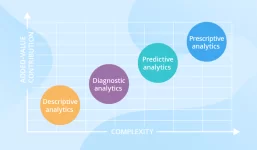
The four phases of analytics are usually defined as a systematic process of data understanding and extraction of value from data. The four phases of analytics help an organization move from raw data to actionable insights. The four phases are
1) What happened : Analytics of past - Descriptive Analytics
Generally this can be achieved by charts, graphs, dashboard, reports etc. This can be achieved even without coding knowledge and with little domain knowledge.
Purpose: For describing or summarizing the data in the past so that one comes to know of what has actually happened.
Focus: It responds to the query, "What happened?"
Tools / Methods: Aggregation of data, mining of data, visualization of data (for instance, dashboards and reports) and simple statistics (mean, median, mode, etc.).
Illustration: It would include a company's sales report for the past quarter or visuals like bar and pie charts capturing the demographics of the customers.
2) Why it happened : Reasons for event - Diagnostic / Exploratory Analytics
For this kind of Analytics we look out for a reason of event (like there is no effect without a cause). To achieve this one needs to be a domain expert and with little coding and mathematical knowledge.
Purpose: It is to study and identify the reasons behind previous events or results.
Focus: It responds to the query, "Why did it happen?"
Methods / Tools: Comparing data, correlation analysis, root cause analysis, and even techniques such as regression analysis or hypothesis testing.
Illustration: Identifying the cause for which sales went down in a certain region based on analysis like weather conditions, marketing campaigns, and competitors' actions.
3) What will happen : Prediction / Forecasting - Predictive Analytics
For this kind of Analytics we look out about what is future going to be. To achieve this one needs to be a domain expert with good functional programming knowledge in terms of coding and mathematical with Machine Leaning knowledge.
Purpose: The purpose of this tool is to forecast future trends or outcomes based on historical data.
Focus: It responds to the query, "What could happen?"
Methods / Tools: This is done through the use of statistical modeling, machine learning, time-series analysis, forecasting, and predictive modeling.
Illustration: Using history sales data in order to be able to estimate future sales over the next quarter or predict that a customer could churn based upon past behavior.
4) Conditional Future : What we expect from future - Prescriptive Analytics
For this kind of Analytics we look out for what we expect from future. To achieve this one needs to be a domain expert with good functional programming knowledge in terms of coding and mathematical with Machine Leaning knowledge. Also we need to tune the parameters to achieve desired future.
Purpose: To provide recommendations for the best course of action or strategies that would help to optimize the outcomes and realize the desired goals.
Focus: It responds to the query, "What to do?"
Methods / Tools: Optimization models, decision analysis, machine learning, simulations, and scenario analysis.
Illustration: Providing a recommendation of best pricing for a product or which supply chain change will lead to the cost reduction.
Summary of the 4 Phases:
Descriptive Analytics: Past performance.
Diagnostic / Exploratory Analytics: Identify why outcomes failed in the past.
Predictive analytics: Forecasts future trends or events.
Prescriptive Analytics: Recommend actions to better future outcomes.
These cycles are cumulative of each other that start from a description of what happened to actually taking informed decisions based on forecast and optimization done.